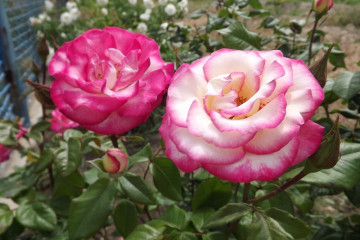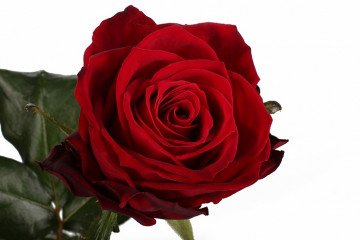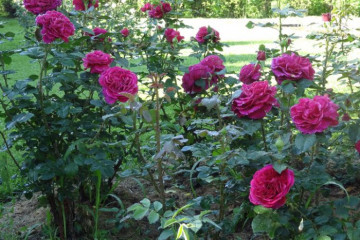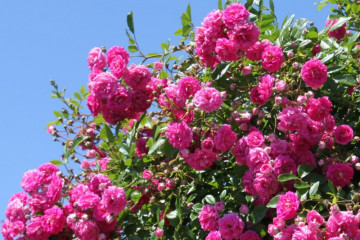Rose Iceberg
Content:
Rose Iceberg is considered a very beautiful and unpretentious plant. It is characterized by stunning white flowers that delight summer residents throughout the warm season. The culture is undemanding to care, and therefore even inexperienced growers can grow it, but they still have to follow some rules.
Rose Iceberg (Iceberg) - what kind of variety, history of creation

Rose iceberg has beautiful white flowers
Rose climbing white Iceberg was created by the German scientist R. Cordes. This happened in 1958. The plant is a multi-flowered floribunda that has amazing decorative properties.
Brief description, characteristic
According to the description, the Iceberg hybrid tea rose is characterized by beautiful flowers of a white or cream shade. They have a yellow center. As the temperature decreases, the flowers acquire a pinkish color. They have semi-double petals. Flowers reach 9 cm in diameter. Each inflorescence contains 2-3 buds.
The bushes are of medium size. They can grow up to 1-1.5 m in height. In this case, the shoots have a light green color.
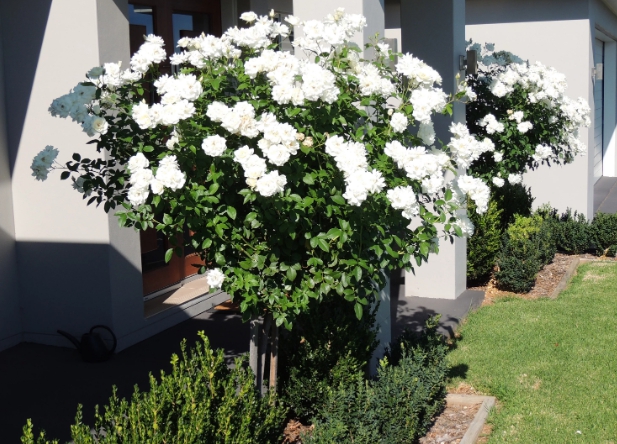
The bushes are medium in size.
Advantages and disadvantages of the variety
The climbing rose Iceberg is characterized by the following advantages:
- lush and abundant flowering;
- the possibility of re-flowering;
- the original structure of the flower and the unusual shade of the petals;
- pleasant aroma of buds;
- rapid growth;
- frost resistance;
- average resistance to disease.
At the same time, Iceberg roses have some disadvantages:
- the need for a solid support structure;
- the risk of black spot damage when grown in humid climates;
- inability to use cut colors.
Use in landscape design
Climbing rose Iceberg is actively used in landscape design. This culture has proven itself especially well when grown on a trunk. Also, the shrub is suitable for decorating alpine slides and lawns. He can curl very nicely over a gazebo or a fence.
Recently, white monochrome gardens are becoming more and more popular. As a basis for such plantings, you can use the Iceberg climbing rose.
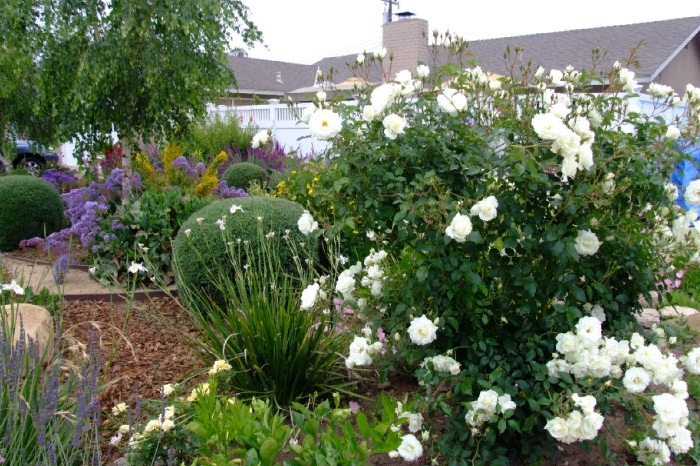
The plant is great for use in landscaping
Growing a flower, how to plant it in open ground
Despite the fact that the Iceberg park rose is considered an unpretentious plant, it requires proper planting.
In what form is the landing
For planting a plant, it is worth purchasing ready-made bushes. At the same time, the purchase of planting material should be treated very responsibly. You should not purchase seedlings in untested places.
Before buying, you need to carefully study the bush.It should be healthy and have shiny, evenly colored leaves. If possible, it is worth examining the roots. They must be well developed and free from pests, rot, mold.
It is also permissible to propagate the plant by seed. However, you need to buy planting material only in proven places. Only in this case it will be possible to preserve the varietal characteristics of the culture.
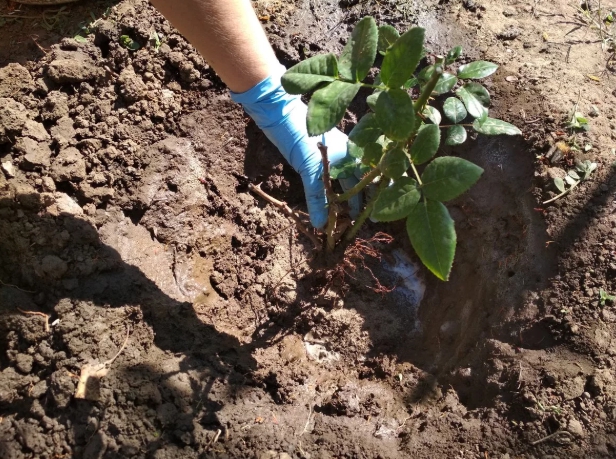
2 or 3 year old seedlings are suitable for planting.
What time is the boarding
When determining the planting period, climatic features should be taken into account. In this case, usually the rose can be planted in the spring - from mid-April to mid-May. You can also do this in the fall - from the end of August to September.
In regions with a harsh climate, planting dates must be strictly observed. If they are violated in Siberian conditions, the likelihood of the death of the culture is high.
Location selection
To plant a plant, you must choose the right place. This variety needs a light soil that contains a lot of humus. Groundwater should not be located near the surface itself.
How to prepare the soil and flower for planting
When preparing a bed, you need to take into account the type of soil. When planting a plant in clay soil, it is necessary to add sand and humus to it. The sandy soil should be mixed with sawdust or compost.
It is recommended to soak the seedlings in water about 3-4 hours before the procedure. This will facilitate the procedure. Carrying out pruning of roots and excess shoots is of no small importance.
Planting procedure step by step
To carry out planting work, you need to do the following:
- Before planting, the roots of the seedlings should be cut off. It is also worth removing unnecessary shoots - 3-4 branches should remain on the bush.
- Make indentations for planting at a distance of 1.5-2 m.The depth of the hole is 70-90 cm, the width is 70 cm.
- Place the nutrient composition on the bottom. To do this, you can mix sand, turf and humus in a 2: 1: 1 ratio.
- Immerse the seedlings in the ground and sprinkle with earth.
- Water the plants.
Plant care
In order for the Iceberg rose to develop normally, it needs to be provided with full and high-quality care.
Watering rules and humidity
It is recommended to water the plant at the root. In this case, it is important that water does not fall on the bush itself. Also, the soil should not be allowed to dry out. Use warm water for irrigation.
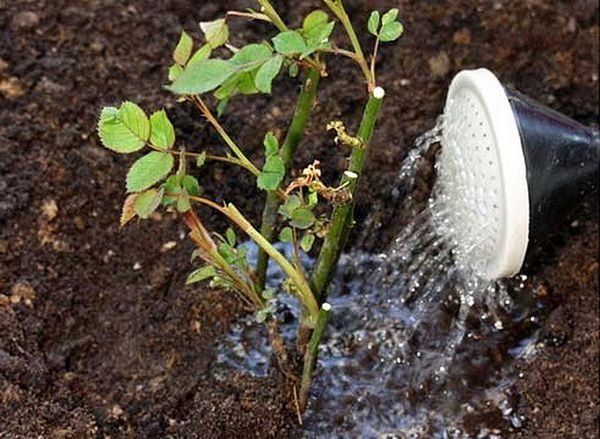
Water the flower at the root
Top dressing and soil quality
A rose of this variety can be fed with humus, peat or compost. These substances are introduced into the trunk circle. At the beginning of summer, it is worth using a complex mineral composition 2 times. It is also permissible to use ammonium nitrate.
Pruning and replanting
You need to cut the bush in the fall or spring. During the procedure, shoots older than 3 years must be removed on the ring. In this case, it is necessary to leave branches 1-2 years old. Shoots of last year need to be pruned into 3 buds.
Features of wintering a flower
For the winter, the bushes need to be additionally covered. In this case, you should first bend the branches of the plant to the ground and fix them. You can insulate the bushes with spruce branches. With the arrival of spring, it must be immediately removed and then the damaged branches should be cut off.
Blooming rose
The plant is characterized by lush and abundant flowering. Thanks to this, the culture serves as a real decoration of the site.
A period of activity and rest
The period of maximum activity falls on the flowering stage. It is considered to be quite long - from May to September. After the arrival of frost, the culture begins a period of dormancy.
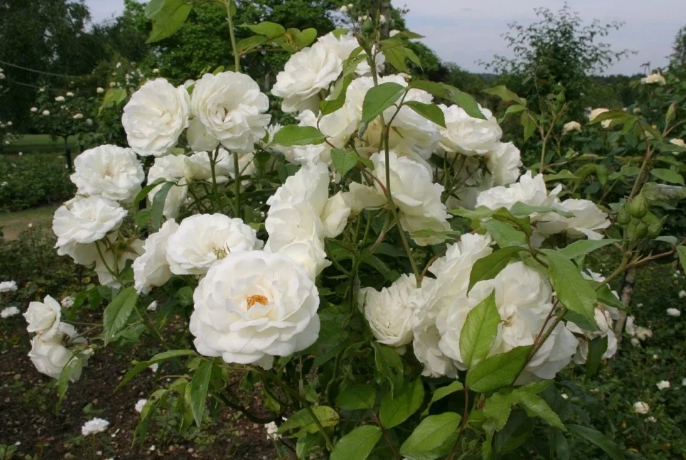
The rose is characterized by lush flowering
Care during and after flowering
During the flowering period, you need to remove the faded buds. It is also worth feeding the bushes with minerals and organics. After flowering is complete, a combined mineral composition must be applied.
What to do if it does not bloom, possible reasons
The lack of flowering can be due to such factors:
- wrong choice of landing site;
- lack of sunlight;
- lack of proper care;
- damage by diseases or parasites.
In order for a rose to bloom magnificently and profusely, first of all, it is necessary to choose the right place for planting it. Observance of agrotechnical recommendations is of no small importance: proper watering, loosening, pruning, fertilization. It is also worth carrying out the prevention of disease and pest infestation.
Flower propagation
A rose of this variety can be propagated in different ways: by grafting, seeds, cuttings or layering. In this case, vegetative methods are used more often.
When is it produced
Cuttings should be harvested in the fall and stored until spring. They are then planted in the soil in May. Seed or layering should be started in spring. The vaccine should be done in July or August.
Detailed description
To propagate a rose by cuttings, you need to do the following:
- Cut the shoots from faded or flowering branches. Each of them must have at least 2 internodes.
- Remove the top leaves halfway and cut off the bottom leaves completely.
- Place the cutting in a container with soil and sand, deepening 2 cm.
After planting the cuttings in the ground, you need to organize a greenhouse and constantly keep the soil moist. The plant should be in a well-lit area.

The rose can be propagated by cuttings
You can also spread the rose with layering. To do this, a healthy shoot must be bent to the ground, laid in a 10 cm groove, fixed and sprinkled with a thin layer of soil. During the summer, the soil needs to be watered all the time. By the fall, fresh roots will appear on the bush.
Another breeding method is the grafting of a rose on a rose hip. It is best to carry out the procedure in late July or early August. Rosehip needs to be watered well with water. On the root collar, you need to make a T-shaped incision and place the eye cut from the rose in this pocket. Next, you should tightly press the peephole to the neck of the stock and wrap it in film. After that, the bush needs to be spud. After 2 weeks, the film is slightly weakened, and with the arrival of spring, it is completely removed.
To propagate a rose by seeds, you need to do the following:
- Soak the planting material in hydrogen peroxide for half an hour. This will help prevent mold growth.
- Put it on a thin layer of cotton wool soaked in peroxide. Cover the top with another layer of cotton wool.
- Wrap in a bag and refrigerate. Cotton wool should be changed periodically.
- After 1.5 months, the planting material must be transferred to peat tablets. You can also use plastic cups with soil for this.
- In spring, roses should be planted in open soil.
Diseases, pests and ways to control them
The climbing rose of this variety is resistant to most diseases and pests, but sometimes its leaves are affected by black spot. The disease develops in conditions of high soil moisture. A diseased bush needs to be dug up and transplanted to a new place. After that, the plant should be treated with antifungal agents. In neglected cases, the bush will have to be destroyed.
Rose Iceberg is considered a popular decorative culture that is often used in landscape design. To achieve success in growing it, you need to water and feed the bushes in a timely manner.
